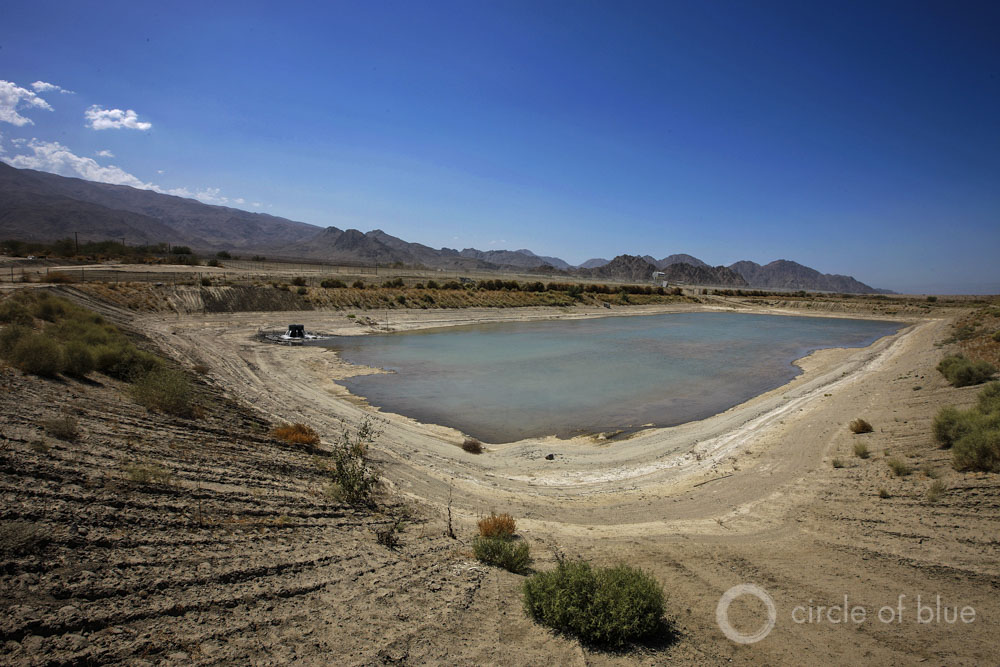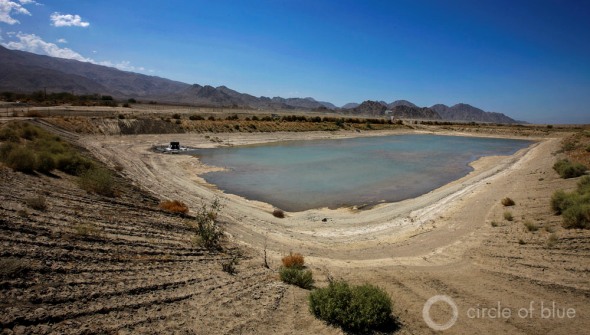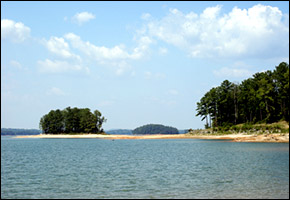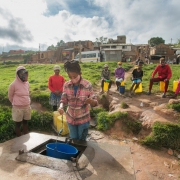California Water Restrictions Generate Flood of Resistance
Cities object to mandatory limits on water use.

By Brett Walton
Circle of Blue
California regulators writing the first mandatory urban water restrictions in state history are encountering a deep pool of discontent as many cities in dry California seek to reduce their proposed water conservation target.
In comments submitted last week to the state authorities in charge of writing the new rules and in interviews with Circle of Blue, municipal water suppliers said they fully support saving water. But the water providers also asserted that the requirements to cut statewide urban water use by 25 percent are too blunt, too severe, fail to reward previous efforts to reduce water use, and ignore the peculiarities of a geographically, hydrologically, and financially diverse state.
–Christopher Alakel, water resources manager
Paso Robles, California
The mandatory requirements also come as the California courts seem prepared to drastically limit the use of a decades-old water conservation tool: tiered pricing. Last week, California’s Fourth District Court of Appeals ruled that charging those who use the most water more than those who use less violates a voter-approved amendment to the state Constitution.
“We’re required to do a lot without the tools we need,” Christopher Alakel, water resources manager for Paso Robles, a wine town north of Santa Barbara, told Circle of Blue.
On April 1, Governor Jerry Brown, a Democrat, announced the mandatory water restrictions, an emergency response to the four-year-old drought that affects all of California. Under the executive order that authorizes the mandatory restrictions, the largest water suppliers must cut use between 8 percent and 36 percent compared to 2013, according to draft rules published April 18 by the State Water Resources Control Board. Each city’s target is based on three months of water use last summer. Cities with higher consumption — typically those in wealthy coastal enclaves and arid interior regions — must cut more deeply than those where residential water use is low.
The Water Board received more than 200 comments from city officials, trade groups, and citizens about the draft regulations. Nearly every city in the strictest conservation tiers is lobbying to reduce its target. Some want an exemption for investing in recycled water or desalination, or for banking water in underground aquifers during wet years. Desert cities argue that they should not be penalized with strict targets because months of 100 degree Fahrenheit temperatures increase water demands. Many of the residents in poorer desert communities use water not for lawns but for “swamp coolers” that evaporate water to cool their homes. Other cities claim that they merit an exemption because they have sufficient local supplies and do not import water from big state reservoirs. Still others want a second set of targets based on winter use.
Changing Values
On the surface, the task of setting mandatory water restrictions is a technical exercise in establishing limits and measuring consumption. The emergency restrictions, though, have also opened a broader discussion about values. What is the appropriate use of water? Who should use scarce supplies and at what cost? How does a city invest in its water future?
With supplies pushed to the limit, nearly every use of water is being questioned. Residents in more than a dozen coastal communities are asking whether stripping the salt from seawater is worth the cost. For Santa Barbara, which will likely spend $US 40 million to restart a mothballed desalination plant, and for San Diego, which expects fresh water this fall from a $US 1 billion desalination facility, the answer is yes.
The governor’s water conservation mandate, clearly targeting urban lawns, has reframed that green patch of middle-class Americana as a symbol of waste.
And communities from Sacramento Valley in the north to the Imperial Valley near the Mexican border are questioning whether the size of the state’s farm industry, for decades America’s top producer of nuts, fruits, and vegetables, is the right match for its water resources. Though farmers will get no water from federal canals this year, Brown’s conservation order did not ask the agriculture sector for additional cuts.
This strikes some observers as inequitable. Don Zdeba, general manager of Indian Wells Valley Water District, 240 kilometers (150 miles) north of Los Angeles, pointed out to state authorities that one alfalfa farm in his district uses as much water as all the towns combined, and it faces no water limits.
“While 30,000 people in the community served by IWVWD are being targeted by state mandate to conserve another 36 percent, local agriculture continues to ramp up groundwater use in the valley for pistachios and pump 1.5 times urban use to grow alfalfa,” Zdeba wrote to the Water Board on April 21.
These and similar questions will grow in urgency as reservoirs drain and more wells go dry.
“What we’ve needed to do as a culture is to recognize the value of water,” Martin Querin, water resources manager for the city of Vallejo, told Circle of Blue. The drought and its fallout, Querin said, is shining light into areas such as infrastructure investment that are often neglected.
Local Action Not Sufficient
The mandatory restrictions are necessary, Brown administration officials argue, because municipalities are not doing enough on their own to conserve. In January 2014, the governor asked for a voluntary 20 percent reduction, but the target was met only once since monthly reporting began last June.
“Many cities haven’t stepped up to meet that goal,” said Mark Ghilarducci, director of the California Office of Emergency Services, during an April 1 press conference to announce the mandatory cuts. “This year has to be different.”
The governor’s April 1 executive order also pointed a finger at local administrators: “I find that conditions of extreme peril to the safety of persons and property continue to exist in California due to water shortage and drought conditions with which local authority is unable to cope.”
Lawn Gone
Given the short timetable for implementing the rules, the playbook for meeting the Water Board’s target is similar across the state. Suppliers are taking aim at outdoor irrigation, the biggest source of savings. Maintaining green lawns can account for more than half of residential water use in a California city. In Bakersfield, an oil town in the Central Valley, lawns and gardens consume 75 percent of city water, according to Jason Meadors, water resources director.
The Bakersfield City Council passed an ordinance on Wednesday to limit lawn watering to three days per week in hopes of meeting its conservation target of 36 percent.
“By restricting watering we’re confident that we can reduce our consumption,” Meadors told Circle of Blue. “But a 36 percent cut will be difficult to hit.”
Other suppliers are throwing money at the problem. The Metropolitan Water District of Southern California, a wholesaler that supplies half of California’s 38 million residents, boosted its conservation budget to $US 100 million over the last two years. Four dollars out of five will go to homeowners who replace water-loving bluegrass with water-efficient landscaping.
The conservation mandate will not only affect the lawn. Deep cuts in water use will test the financial durability of utilities. A utility is in the business of selling water. If sales drop, so does the revenue that the city uses to maintain, operate, and repair the system that delivers clean water at the turn of a faucet.
“There are costs associated with that much conservation,” said Alakel of Paso Robles, which has a 28 percent conservation target. “The state thinks that we can just absorb the financial hits.”
“It’s getting more and more difficult to satisfy the requirements,” Alakel added. “Having the ability to use tiered rates would have gone a long way but it looks like that was taken away from us by the courts.”
The Water Board is trying to be more flexible by showing a willingness to modify the targets. A regulatory framework published on April 4 proposed four conservation tiers. Now there are nine. A second draft will be presented on Tuesday, April 28, and the Water Board will vote on the final rules at its May 5 meeting.
Though the details are still being negotiated, the results will likely lead to a long-term transformation of the city landscape.
“Our culture in general is reactive,” Querin said. “Shortly after the crisis we tend to go back to the way things were. But will we go back to treating water as we did 20 years ago? No.”
Brett writes about agriculture, energy, infrastructure, and the politics and economics of water in the United States. He also writes the Federal Water Tap, Circle of Blue’s weekly digest of U.S. government water news. He is the winner of two Society of Environmental Journalists reporting awards, one of the top honors in American environmental journalism: first place for explanatory reporting for a series on septic system pollution in the United States(2016) and third place for beat reporting in a small market (2014). He received the Sierra Club’s Distinguished Service Award in 2018. Brett lives in Seattle, where he hikes the mountains and bakes pies. Contact Brett Walton
Leave a Reply
Want to join the discussion?Feel free to contribute!










I find it disturbing that during this very dry year, that water was being released on the south fork of the American river last tuesday, for no other reason than to maintain water temps for the fish… But seeing as we’ll likely dead pool those reservoirs late this summer it really doesn’t matter what they’re doing for the fish now except prolonging the inevitable demise of the fish later this summer and along with that we run out of water.. where is the sense in that??
Of the total available water supply in California 50 percent goes to the Environment, that is it run’s from the Mountains and out to the Sea, 40 Percent goes to Farming and the remaining 10 percent is Residential. Of that remaining 10 percent if the governor gets his way we will save 2.5% of the total water used (10% x .25). Yet we are all focusing on that little slice of water as if it will somehow solve our problems. Maybe we should take 1 or 2 percent from the Environments side and give it to the Residential?
Bob stop coming up with these silly ideas that make too much sense. Our government is only interested in things that make no sense.
If the voters can approve an amendment to the Constitution, it’s NOT a Constitution. It’s just a body of laws. Democracy in California is like two lions and a sheep figuring out what’s for lunch. There’s no accountability, so voters keep reducing taxes and increasing benefits, and something as important as water in a drought is subject to public opinion polls.
Nobody’s in charge, and everyone loses.
Interesting that a government employee would cry that we are not given the tools we need to get the job done. Exactly what tools does Chris in Paso Robles need to get the job done? Does he even know what tools he needs or does he even understand what he needs to do? Sounds like a lazy government employee who can’t do his job unless he can hire a consultant.
“Maybe we should take 1 or 2 percent from the Environments side and give it to the Residential?”
If you don’t have any “Environment” to live in, you would be called a former “Residential”.